Trip Report - 11-3-13
Today was not a many day. It was a many, many day. Even from the start I wasn't counting, but Coach and I each caught lots and lots of fish. Most were bluegills, but I ended up catching a redbreast sunfish, a white perch, a pumpkinseed sunfish and more than a few largemouth bass.
The flies of the day were a black Killer Bugger and an olive Killer Bugger. I probably caught more on the black than the olive, but only because I fished it longer. The olive was just as effective.
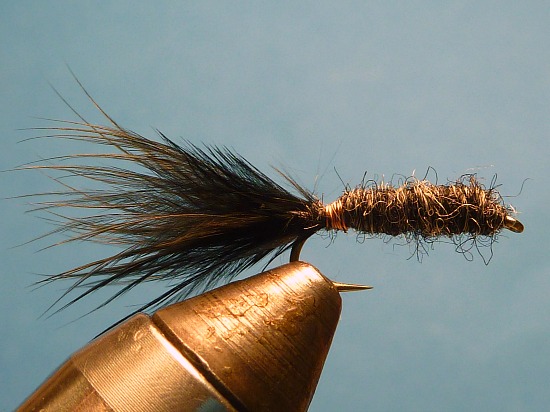 Black Killer Bugger
Black Killer BuggerWe started out on a stream where Coach had caught some surprisingly large trout in the past. The water was extremely low, though, and there were no trout - or at least, neither of us hooked one, spooked one or even saw one. I caught a couple small sunfish, and then we decided to try another spot.
We both started catching sunfish immediately. They weren't large by any means, but they were plentiful and aggressive.
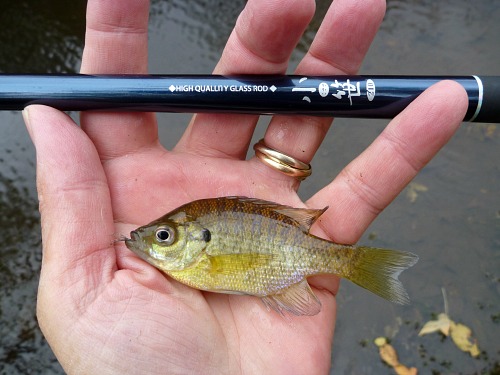
That was a fairly short stretch of stream, though, and it wasn't too long before we moved again. We went to a lake in a county park, where we both caught more bluegills, Coach caught a yellow perch and I caught a white perch. Where we were fishing was pretty exposed to the wind, though, so we soon moved again.
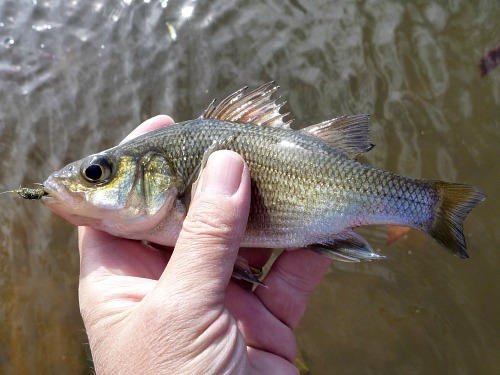
We then went to a couple ponds in an office park. I would highly recommend checking out the ponds in office parks (if there aren't any No Fishing signs). Lots of office parks have them, and I would bet nearly all have fish and rarely get fished.
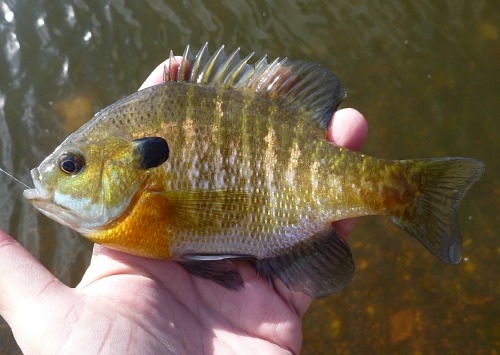
Here again, the fish weren't that large, but they were plenty large enough to put a bend in the rod. Well, at least most were. I caught quite a few little largemouth bass. Surprisingly, Coach didn't catch any bass. He made up for it with bluegills, though. He found one corner of one of the ponds where he caught a fish on every cast, over and over and over.
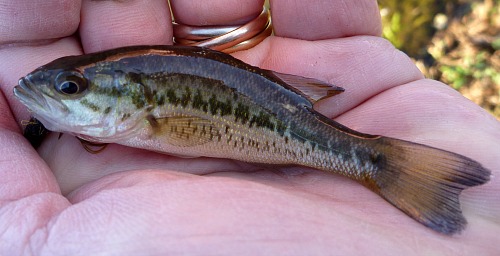
Not all the bass were quite that small. They were plenty large enough to be fun on a light rod, though.
It was here that I tried a new (to me) technique for bluegills.
I should say right up front that I have never been an indicator fisherman - even before I learned about tenkara and started fishing a fluorescent orange line - which I've told more than a few people eliminates the need to fish with an indicator. "Your line is the indicator" is how I think I've generally put it.
What led me to fish with an indicator today was thinking about how seiryu anglers in Japan fish. They use rods like the Suntech Kurenai or Nissin Air Stage Hakubai (both of which I love) with light lines (which I love) and floats (which I really haven't tried much at all). Plus, a recent submission by a customer explained how effective a Thingamabobber was while fishing with the titanium line. Putting the two together, I decided to try the smaller Unibobber while fishing with a light fluorocarbon line.
I spent about half the day fishing with a Unibobber as an indicator and had my eyes opened. I suspect it will become my "go to" method for bluegill fishing, not because my previous method - watching for the line to twitch - wasn't working. I thought it worked fine. It's just that fishing with an indicator works better!
This past summer I fished for bluegills with porcupine quill floats. It was interesting but getting the quill to float half in and half out of the water was tricky. Plus, the fluorocarbon line would sink if I let it lay on the water and it would pull the float over if I kept it tight. Today I just used a Unibobber.
The
Unibobber is a very small (5/16") Thingamabobber that was actually
designed for fly tying - you incorporate it into a fly as you tie it,
making the fly unsinkable. I sold them as floats for micro fishing,
and they are probably better for micro fishing than for fly tying. They
are small enough that they don't affect your cast much - some but not
too much. The 3/8" Nakazima Ball Float is about the same size and should work in the same way.
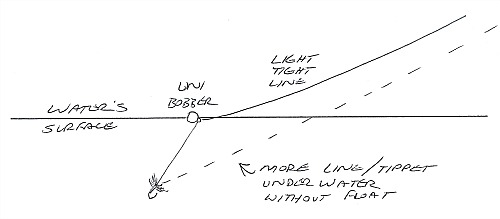
What you can do with the Unibobber that you really can't with the porcupine quill float is keep a tight line - to the point that there is no line on the water. The Unibobber acts a bit like a sea anchor, providing resistance and keeping the line tight. That does pull the Unibobber towards you, but that also keeps the line tight between the Unibobber and the fly. Since there is no slack at all, when a fish sucks in your fly, the Unibobber reacts instantly. If the pond's surface is calm, it is easier to see the Unibobber react than to see a tight line react. You can also fish deeper, slower and with less line in the water so it is easier to see the strike.
We ended the day fishing a
pond in a condo development. Like office park ponds, they probably all
have fish and they probably don't get fished much. If you can fish one,
do. There, it was my turn to catch a fish on every cast - over and over.
I have read many times about fishing a soft hackle under a
panfish popper but I'd never tried it. November isn't the best time of
year to fish panfish poppers but next year I will definitely try a panfish popper
or a foam beetle or a CDC & Elk with a soft hackle or sakasa kebari underneath - or a Killer Bugger, which certainly worked today.
I'm not sure I'll use Unibobbers for nymphing in trout streams but I will definitely do a bit more dry - dropper fishing, with a soft hackle or sakasa kebari or small Killer Bug under a CDC & Elk. People always talk about fish striking their indicators and to me it makes perfect sense that if the fish are going to do that you ought to put a hook in it. With a light enough fly underneath, a CDC & Elk, which is great fly on its own, ought to be the perfect indicator.
TenkaraBum Home > Trip Reports > Trip Report - 11-3-13
“The bitterness of poor quality remains long after the sweetness of low price is forgotten” - Benjamin Franklin
"Be sure in casting, that your fly fall first into the water, for if the line fall first, it scares or frightens the fish..." -
Col. Robert Venables 1662
As age slows my pace, I will become more like the heron.
We've all had situations where seriously chewed up flies kept catching fish after fish after fish. It is no sin to tie flies that come off the vise looking seriously chewed up.
Warning:
The hooks are sharp.
The coffee's hot.
The fish are slippery when wet.
Beware of the Dogma
What's in stock?
Suntech Tenkarakyo 40F Tenkara Rods
Daiwa Keiryu-X 39
Nissin Oni Tenkara Line
Coming Soon
December
Kurenai II AR 30F
Kurenai II AR 33F
Kurenai II AR 39F
Nissin Oni Line size 3
Nissin Oni Line size 3.5
TenkaraBum 33
TenkaraBum 36
TenkaraBum 40
Medium Rod Case
January
Furaibo TF39
Furaibo TF39TA
Latest Pages
If you enjoy spin fishing or baitcasting please visit my sister site Finesse-Fishing.com.


